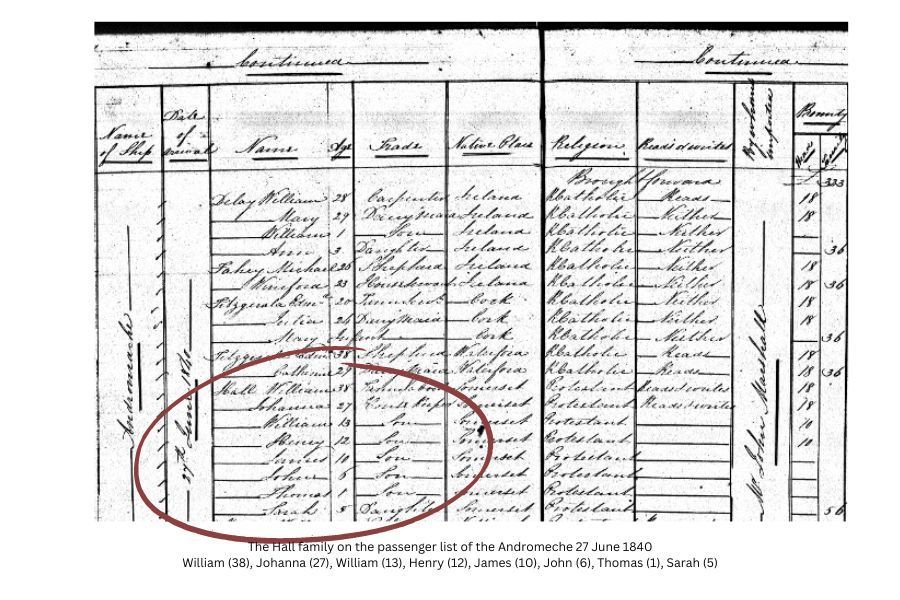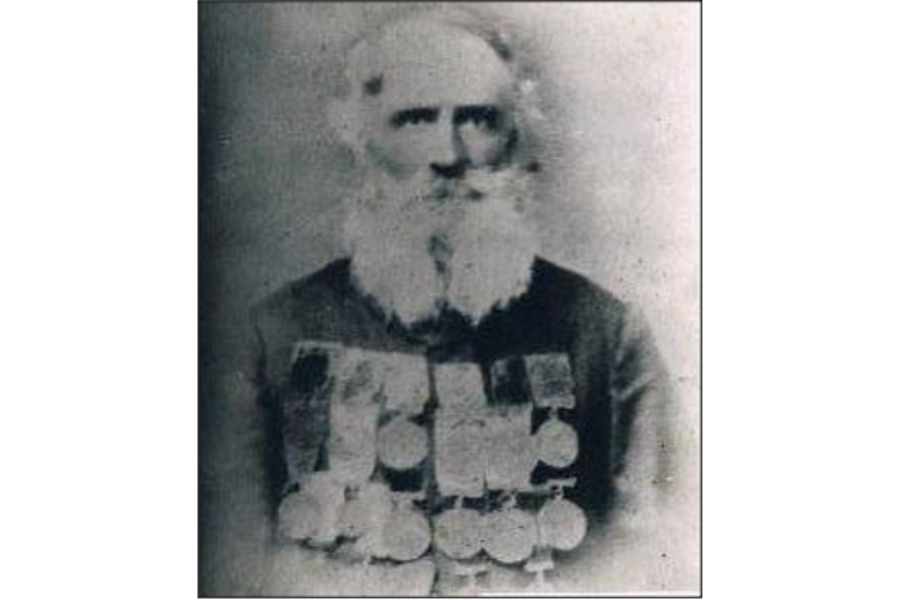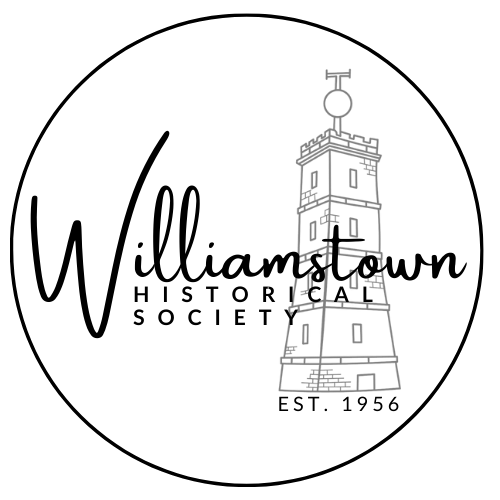Williamstown Notables - William Hall

Early settler, entrepreneur, landowner, business man
Born: 26 October 1800, Paulton, Somerset England (about 10 miles SW of Bath)
Arrived: in Australia 19 June 1840
Died: 4 May, 1889, Williamstown, Victoria
William Hall was one of Williamstown’s earliest settlers. He was born in 1800 to parents William Hall the elder and Sarah Tidcombe. His father was a blacksmith and inherited a small farm near Radstock, Somerset where William grew up. He married Lucy Marchant on 27th March, 1826 at St James Church, Bath, Somerset. They went on to have nine children before his wife died in February 1837, leaving five living children.
At the time of his wife's death, Mr Hall was renting the parsonage farm at Wolverton near Frome, Somerset. After
Lucy’s death and with five children to care for, he quickly married Johanna Noad, on 6 November 1837. Johanna was the daughter of a butcher from the nearby village of Road (now Rode), which would stand them in good stead when they finally arrived in Williamstown.
With nothing on offer in Somerset after several failed businesses, William decided to emigrate and the family set sail from Plymouth on 29 February 1840 on the barque Andromache, arriving in Port Phillip on 19 June 1840.

Not long after the family’s arrival, the whole family were hired for 12 months by Mr Hains, a butcher whose business was in Nelson Place, nearly opposite the end of the jetty (Gem Pier). Their contract was for 12 months and they were paid £80 along with a house, fuel, water and food for all.
The family were not long in town when the two eldest boys and William moved to live in a tent near North Williamstown railway station, in charge of John O'Neill's sheep station. Soon after their contract with the butcher expired William Hall bought two small building lots near the corner of Parker and Cecil Streets for £70 from the late Mr James Purves, father of Mr Purves, Barrister. Here he built a tenement building on one block which was the family home. The three oldest boys left home and were engaged by different employees as shepherds while William purchased a pair of working bullocks to cart goods. In 1843-44 he was employed by butcher Thomas Wilsmore whose shop was near the Woolpack Hotel, Nelson Place.
In 1846, along with Mr Wilsmore, he purchased a squatting tenure in a plot of land at the mouth of the Kororoit Creek where they ran a farm. However, there was a disagreement and William Hall and the family then moved to Yarraville.

In 1847 he purchased 100 acres, 3 roods and 32 perches at 22 shillings per acre costing a total of £111, 1s, 11p. The land ran from near the mouth of the Yarra River to Melbourne Road. Originally it was called Point Pleasant Farm but Hall renamed it Hobsons River Farm. In 1853 he was asked if he would sell the land for £16,000 (a huge profit on what he had originally paid) but refused. By early 1848 he had erected a house and a stock-yard, and by October had removed the rocks, grubbed out the trees and enclosed 10 to 12 acres with fences with the land ploughed and sowed with wheat, oats, barley and potatoes.


He had a reputation as a practical farmer, but early in 1860s he gave up growing cereals and devoted most of his time to gardening, cultivating a great variety of fruits and vegetables, and obtained many medals as prizes, and a great number of honourable mention certificates. He was, on particular occasions, in the habit of wearing on his coat some 30 or 40 medals (see above) which he had won, including a gold medal for maize growing.
He made a good income from men quarrying the property and received hundreds of pounds compensation from the Railway Department for the land required for the new Geelong to Melbourne and Williamstown to Geelong railways as the line passed through his land.
He was an entrepreneur, land owner and businessman however some of his enterprises did not always succeed. He erected a wooden hotel which was opened as the Junction Hotel (the first in Newport), which did not turn a profit so he sold the property to James Horsley.
At an auction in 1851, he also purchased land that was known to locals as “Goose Flats” and is in the area we now know as Newport Lakes. The 158 acres were granted as a farm and a pastoral property to William Hall officially in 1852 which he then renamed “Stony Rises”. He purchased the land for £173, 16s.
Rate records from 1863 indicate the above property was leased to Samuel Bunting and Charles Newport with William Hall and Michael Durkin keeping 157 acres and running it as a farm. Durkin’s Dairy was well known in the area in future years.
The area was first recorded as a quarry in the Rate Records of 1868-69 being run by a Mr Doherty. Hall also leased one acre of the property to James Horsley, quarryman and carrier, as a stone quarry. £100 per annum was paid by Mr Horsley and the bluestone quarried was used as ballast by ships returning to Europe from the docks at Footscray, Newport and Williamstown. The bluestone was also an important source of building material in Melbourne with early quarry work being carried out manually by British tradesmen. After his death, this land was willed to Thomas Noad Hall, his eldest son from his second marriage.
In the 1856 Williamstown Electoral Roll, he was listed as a Yeoman of Hobsons Bay Farm, owning land in Cecil Street and owning a farm of 100 acres on Hobsons River, own occupation. He was also one of the 322 resident householders in the town of Williamstown who, in early 1856, petitioned that the said district of Williamstown be proclaimed a Municipal District. For many years he was also the Williamstown pound keeper and was at one time a Williamstown councillor for a term of three years.
He was a large landowner owning several farming plots on the Werribee Plains, a block of land of 158 acres on Blackshaws Road, and some town lots in Werribee township in addition to other properties. He also owned shares in some companies.
He travelled very little after arriving in Williamstown apart from a short time at the gold diggings and at Yarraville despite owning land a little farther afield. He was a man of little education, yet a great politician in his own way, but did not like to be opposed.

He eventually sold the farm during the 1880s land boom, on 5 August 1884 to developers Maxman, Moss, and Fergie and according to newspaper reports, the price was £117 per acre, which totalled between £11,000 and £12,000. The deal allowed William Hall to reside on the farm for some time after it was surveyed into building lots, which he did until he moved into a beautiful Victorian brick cottage at 184 Hall Street, opposite the Spotswood Station on 15th July 1886. The building is still standing and is listed under the Victorian Heritage Database. The Hobsons Farm homestead stood until 1914.
It was here he died on 4 May 1889, leaving an estate estimated to be around £30,000. He is buried in Williamstown Cemetery.
Hall Street, Hobson Street, River Street and Farm Street, Newport were all named after him and his farm.











